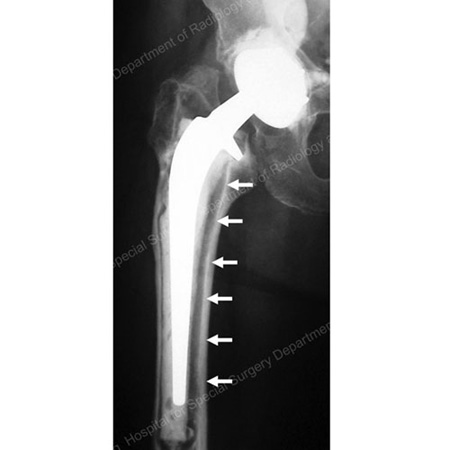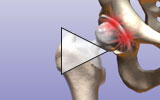Introduction
Conventional, primary total hip replacement is a durable operation in the majority of patients. A hip replacement is a mechanical device with parts that are assembled before and during the operation, most commonly referred to as a “ball and socket.” After surgery, the prosthetic ball and socket restore movement in the hip during the life-span of the prosthesis (Figure 1).
Figure 1: An x-ray of a
total hip replacement prosthesis with labels showing the "ball and
socket."
As with any other mechanical device, a total hip
replacement can be subject to various forms of mechanical or biological failure.
Some of these conditions may require a re-operation of the hip replacement to
address the cause of failure and its consequences. A re-operation of a total hip
replacement is called a “revision.” Why consider a hip revision?
The majority of elderly patients who receive a hip replacement retain the prosthesis for 15 to 20 years, and sometimes for life. However, some patients may need one or more revisions of a hip replacement, particularly if the initial hip replacement surgery is performed at a young age and the patient chooses to have a very active physical lifestyle.Pre-operative investigations in patients who will undergo revision surgery are more extensive than those required in patients scheduled for a primary surgery. Often times, special radiographic (x-ray) projections, CT scan, or MRI of the hip may be necessary to determine position and fixation of the replacement parts (components), and to determine with precision the extent of bone loss around the failed implant. A preoperative aspiration (fluid sample) and/or special blood work may be needed if the surgeon suspects an infection in the failed hip.
Reasons for hip revision
Revision hip replacement is a relatively infrequent operation. In the United States, there are approximately 18 revision hip replacements performed for every 100 hip replacements.(1) The most frequent reasons for revision are:- repetitive dislocation of a hip replacement
- mechanical failure (implant wear and tear – loosening - breakage)
- infection

Figure 2: An x-ray of a
dislocated total hip replacement prosthesis showing the ball forced out of the
socket.
Dislocations are relatively infrequent, particularly in the
healthy patient who carefully follows precautions given by the surgeon and
physical therapist. However, some patients are predisposed to this complication:
the elderly, debilitated patients, or those who get a hip replacement after a
hip fracture or after multiple hip surgeries. Patients who suffered a hip dislocation are predisposed to additional dislocations, as the dislocated ball disrupts the important muscles and ligaments around the hip. Multiple dislocations are infrequent, but in patients who have suffered multiple hip dislocations, the orthopaedic surgeon may recommend revision surgery.
Revision surgery is effective in preventing a new dislocation. Prior to surgery, the surgeon may request imaging studies to determine the exact position and orientation of the different parts of the replacement. One or more parts may need to be re-oriented or completely exchanged during the revision.
In certain instances, the surgeon may use a device that “captures” the ball inside the socket (called a constrained socket). The proper healing of the soft tissues around a revised hip is most important for the success of the operation. Therefore, the surgeon may recommend wearing a brace for a few weeks after surgery. After surgery, it is important to follow the surgeon’s advice and to refrain from moving the hip into positions that can generate a new dislocation.
Mechanical wear, implant loosening, and breakage: The mobile parts of a hip replacement that move against each other will slowly wear and tear during the regular use of the replacement. The younger and the more physically active the patient is, the faster the wear. The wear consists of the generation of very small particles from constant, repetitive movement of the mechanic parts during the use of the hip. Depending on the type of hip replacement, the particles can be made out of plastic, cement, ceramic, or metal.
The patient’s immune system will recognize those particles as foreign and generate an immune response (like an allergic reaction). A strong reaction to the wear particles can result in the destruction of bone around the hip replacement (a condition called osteolysis). If the bone destruction is severe enough, the components of the replaced hip may become loose (Figure 3).

Figure 3: An x-ray of a
loose total hip replacement prosthesis showing separation of the stem from the
bone (as detailed by arrows).
A loose component can move against the
surrounding bone, compounding the bone loss. If the bone loss is severe enough,
a spontaneous bone fracture can occur (known as a pathologic
fracture).Mechanical wear and tear leading to loosening of the prosthesis (implant) is one of the most frequent forms of mechanical failure. However, other forms of mechanical failure are possible, like breakage of the prosthesis (Figure 4).

Figure 4: An x-ray
detailing the broken stem section of a total hip replacement
prosthesis.
During revision surgery for wear, mechanical loosening,
or breakage, the surgeon will remove the worn/loosened/broken component/s, will
assess the amount of bone loss, and will implant new components. Frequently, a
bone graft (cadaveric bone from tested donors) is necessary to rebuild the bone
content of the hip lost during the process of prosthetic failure. In certain
instances, when there is a large amount of bone graft utilized, or when the
patient’s bone stock is poor, the surgeon may ask the patient not to bear full
weight in the operated leg for a period of time after surgery.
Infection of a hip replacement can occur at any time after surgery. The risk is higher in close proximity to surgery (first six weeks). However, after that, there is a low risk of “late” infections. Sometimes, infections in the mouth, gums, teeth, lungs, urine, or skin, or regular dental procedures that involve gum bleeding, can force bacteria in the blood stream. The bacteria can seed and infect a hip replacement, causing hip pain and fever.
In the presence of a prosthetic infection, the surgeon will make an attempt at identifying the organism (bacteria) that is causing the infection. A hip aspiration may be recommended. The liquid aspirated from the hip will be sent to the laboratory and tests performed to determine the type of bacteria present and the antibiotics the bacteria are sensitive to.
Once an infection in the hip replacement has been diagnosed, several treatment options are possible. The vast majority of treatments include surgery and a course of antibiotics specifically targeting the infecting bacteria. The treatment option depends on the type of bacteria, the sensitivity to antibiotics, the duration of the infection, the fixation of the hip replacement parts, and the patient’s general condition. The surgeon will discuss benefits and drawbacks of each treatment option.
The most common treatment options include:
- A thorough surgical cleaning of the hip replacement. This is generally recommended when the infection is discovered very early (within a few hours or days). Patients require six weeks of intravenous antibiotics and, frequently, a low dose of oral antibiotics for a long period of time (sometimes for life).
- A complete exchange of a hip replacement done in two stages: A first stage consists of the complete removal of the hip replacement, cleaning of the bone, and implantation of a temporary cement spacer that will allow some hip motion and deliver antibiotics to the hip area. This is generally followed by a six week course of intravenous antibiotics. The second stage consists of the re-implantation of a definitive hip replacement (generally 6 to 8 weeks after the initial operation).
- A complete exchange of a hip replacement done as a single operation, during which the infected prosthesis is removed, the bone is cleaned, and a new prosthesis is implanted. Patients require six weeks of intravenous antibiotics and, frequently, a low dose of oral antibiotics for a long period of time (sometimes for life).
Step-by-step animation of a single operation hip revision procedure
Preventing the need for revision hip surgery
The importance of awareness and postoperative surveillance: Some of the previously mentioned forms of failure can be prevented.Dislocations can be prevented by following the surgeon’s instructions; some forms of hip infection can be prevented by prompt treatment of other bodily infections and by taking antibiotics before certain dental and other procedures.
The prosthesis’ natural wear and tear is generally painless. Therefore, it is very important that the patient has his/her hip replacement regularly checked. A simple physical examination and radiographs are necessary at the intervals designated by the surgeon. If excessive wear and/or bone loss is detected at any time, close monitoring is necessary to determine the best possible time (if any) to have the hip replacement revised.
Things to keep in mind when considering revision hip surgery
During revision surgery, the surgeon may need to remove or exchange one or more parts of the hip replacement. The parts that are not attached to the bone can be safely exchanged with minimal to no removal of the patient’s bone. However, if the metallic parts in contact with the bone need to be changed, some bone loss generally occurs. In addition, some of the musculature around the hip will be lost, thus affecting the strength of the hip and the patient’s function after surgery. The results of revision surgery are not as predictable as those of the primary surgery. Complications are more frequent.A revision of a hip replacement is generally more challenging than the initial operation and it should not be regarded or compared to a “change of tires on the car.” The results of surgery and the durability of the revised hip replacement are less predictable than those of the primary operation. With every revision surgery, there is some loss of muscular mass, bone, or both. The duration of surgery is generally longer and the likelihood of complications higher than during the primary surgery.
Reference
1. Memtsoudis SG, Besculides MC, Gaber L, Liu S, González Della Valle A.Risk factors for pulmonary embolism after hip and knee arthroplasty: a population-based study. Int Orthop. 2009 Dec;33(6):1739-45.
POSTED BY ATTORNEY RENE G.
GARCIA:
For more information:- Some of our clients have suffered injuries that require a Hip Replacement due to a serious accident. The Garcia Law Firm, P.C. was able to successfully handle these types of cases. For a free consultation please call us at 1-866- SCAFFOLD or 212-725-1313.
Link: http://www.hss.edu/conditions_revision-total-hip-replacement-overview.asp

No comments:
Post a Comment